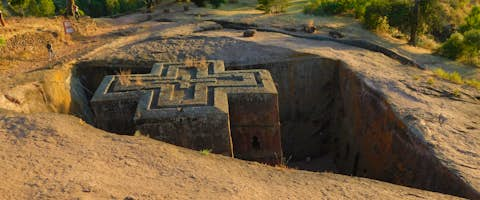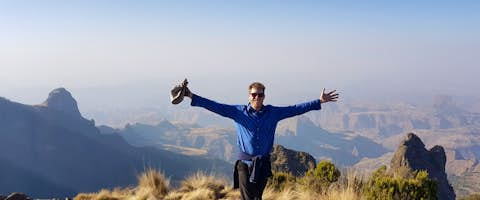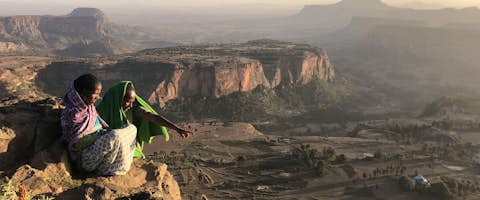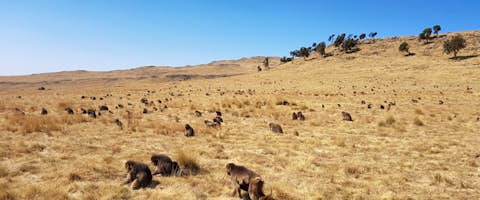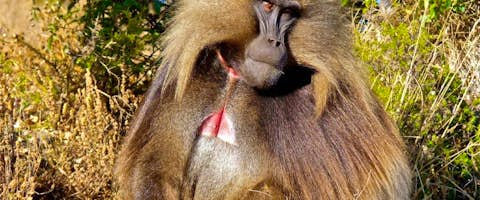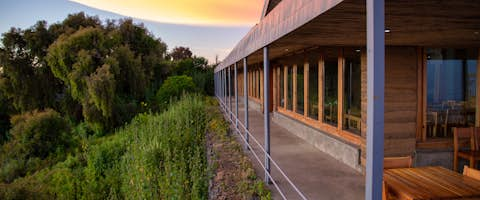Why choose to camp in the Simiens?
- Spending your nights under the stars at 3000m, surrounded by other like-minded travellers, sharing stories around a campfire, is a magical way experience the Simien Mountains.
- Discover the best viewpoints, the hidden trails, and all the wildlife the park has to offer as you trek from camp to camp.
- All camping gear and equipment is provided, so there's nothing additional to add to your suitcase.
- Camping in the Simiens is the most cost-effective way to visit the Simien Mountains.

Brilliant says
All camping equipment is provided for you if you are camping in the Simien Mountains. The equipment isn't as good as we would hope, so we recommend bringing your own sleeping bag if you can, and pack warm clothes for the freezing nights!
The three campsites
Sankaber (3,250m)
Sankaber is the first campsite on most Simien treks, and is a wonderful introduction to the park. The drive from Debark (the entrance town to the Simien Mountains) concludes at Buit Ras near the Simien Lodge. From here, you will begin the trek to Sankaber camp. The route from Buit Ras to Sankaber is relatively mild and works well as an acclimatization hike, although there are some steeper ascents as you are climbing to around 3200 metres.
Sankaber is surrounded by Giant Heath trees (Erica Arboreal) and escarpment edges. The camp is situated on the escarpment edge and has stunning views. Gelada Monkeys often play on the grounds here, and there are a few great viewpoints around the camp that you can explore as you get acclimatised.
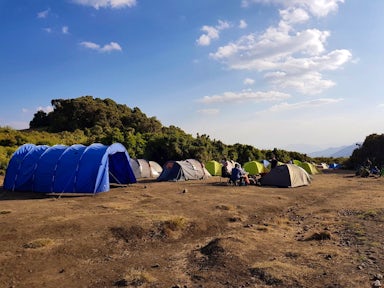
Second night on the Simien camping trail
Geech Campsite (3,600m)
The trek from Sankaber to Gich is 5-6 hours. The Jinbar falls sits between the two campsites, where the Jinber river plunges 500 metres down into the Gich Abyss. The waterfall is highly seasonal, and in the dry season the flow is greatly reduced. The stretch from the falls to Gich follows a gradual incline past the Jinbar river and the (now abandoned) village of Gich before arriving at the campsite. Geech sits in an open portion of land and there isn't much shrubbery around.
The nearby Kedadit viewpoint (3,760m) offers wonderful views of the expansive lowlands to the north, and is a great spot for sundowners. You’ll often have a chance to watch the Gelada monkeys as they return to their sleeping spots in the caves below at sunset.
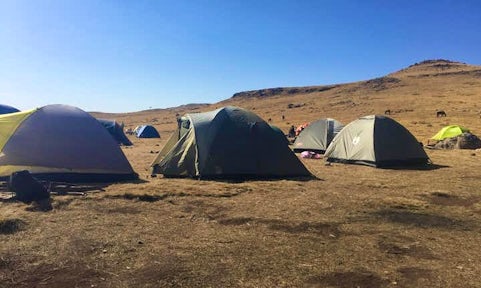
The tents at the campsites are quite thin - bring extra warm clothes!
Chennek Campsite
Chennek is the last campsite along the main ridge of the Simiens, and is as far as you can get by road. Chennek is your best chance to spot the endemic Walia Ibex and Ethiopian Wolf (although the wolf is rarely seen in the Simiens).
There are two incredible peaks between Gich and Chennek: Imet Gogo and Intateye. From Gich, it is a 2-hour hike to Imet Gogo which stands at 3,926m. The 360-degree panoramic views from here are extraordinary, and if you look east across the Bwahit Pass, you’ll see Ras Dashen (Africa’s tenth highest peak) in the distance.
Inateye is a difficult trek involving a relatively steep one hour climb, followed by a more gentle gradient for another hour before reaching the peak at 4,070m. From the peak at Inateye, it is another 2-3 hour trek onwards to Chennek.
Inateye and Imet Gogo cannot be explored on the same day, so if you want to hit both these peaks, you’ll need to spend two nights at Gich, which will also give you time to visit the Saha viewpoint (3,785m) and the Kedadit viewpoint (3,760m) after Imet Gogo, and continue to Inateye the following day.
Chennek has the best views of all the three campsites. Giant Lobelia trees surround the camp, and there are amazing views of Mount Bwahit and Inateye.

Sankaber campsite in the Simien Mountains

Brilliant says
Camping in the Simien Mountains is the most cost-effective way to explore the mountains, and works out much cheaper than staying in the nearby lodges. We do recommend tagging on a night at Limalimo Lodge at the end of your trek, a beautiful lodge and a great spot for some R&R after three nights camping in the mountains.
Campsites Further Afield
For those looking for more than just an introduction to the Simien Mountains, you can continue past Chennek and find some wonderful campsites or basic homestays that give you access to some extraordinary sections of the park, including the mighty Ras Dashen - Ethiopia's highest peak.
-
Ambiko (3,600m)
Ambiko is the base camp for trekking Ras Dashen, Ethiopia’s highest peak (and Africa’s tenth) at 4,553m. The trek from Chennek to Ambiko takes you to the summit of the Bwahit Pass at 4,200m (3 hours from Chennek). Bwahit is the second highest peak in the pass, and offers great views of your upcoming challenge: Ras Dashen.
From Bwahit, you head east towards Ambiko, passing through farmland and dwellings. Ambiko sits next to a local church, so you can sometimes witness the priests arriving in their robes for service.
-
Mentaber (3,550m)
Mentaber campsite sits just north of Ambiko and is mostly used as a connecting point between Ras Dashen and the lowland treks that begin at Arekwaseye and Sona.
-
Arekwazeye (3,600m)
Arekwazeye is a transition camp between high altitude Simien trekking, and the lowland hikes to the north as you head down from the escarpment. The hike from Mentaber to Arekwazeye is a 7-hour hike that passes through a number of fantastic viewpoints, most notably Kidus Yared, Silki, Waliakend, and Berochwuha (the final high peak along the circuit).
-
Sona (3,020m)
Sona is the last high altitude campsite, and marks the start of the lowland trekking to the north. The lowland routes see far fewer trekkers than the primary ridge in the Simiens, so you’ll likely have the camp all to yourself.
-
Mekarebya (1,900m)
Mekarebya is the first real low altitude lodge along the lowland trail. The lower altitude means temperatures are warmer throughout the day. The starlight in this part of the country is extraordinary, and the warmer evenings mean you can enjoy the views over sundowners.
If you’re coming from Sona, the day’s trek is about 7 hours. The first part of the trek is a 3-4 hour descent hike from Sona to the Anisya river that feeds the larger Tekeze river. The remaining trek takes you across flatland where you will pass local villagers. The lowland treks are a great way to meet local people and learn about the local way of life.
-
Mulit (2,050m)
Mulit is the final overnight stop of the lowland trek. From Mekarebya, it is a 5-6 hour hike along relatively flat land, with a steep ascent for the last 2 hours.
Campsites in the Simien Mountains
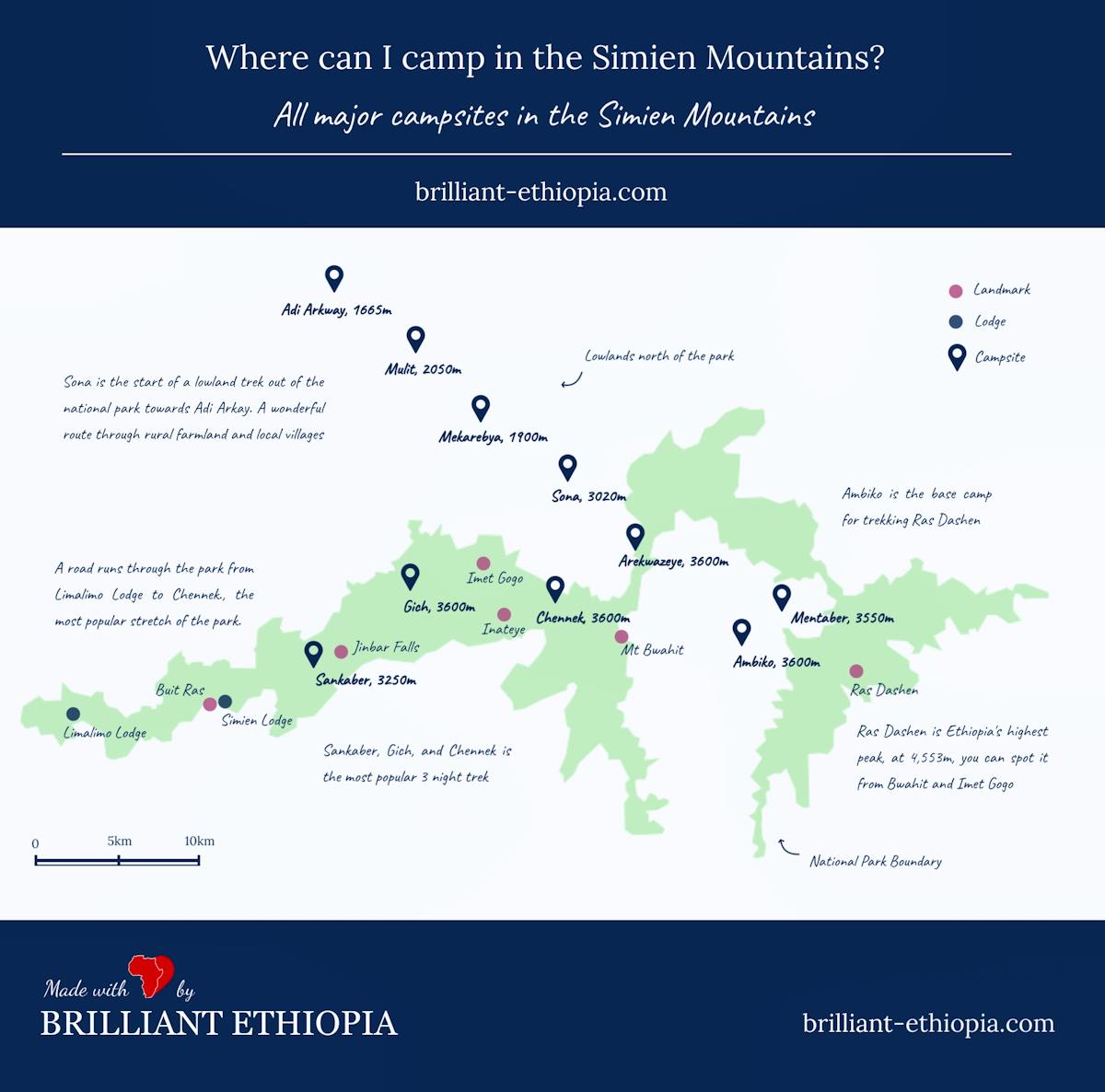
Camp in the Simiens on these trips
There are so many ways to explore the Simien Mountains. Below are just some examples - but whatever you have in mind, we'd be happy to help arrange your adventure.
Ready to plan your Ethiopia adventure?
Listen
We'll spend some time listening to your aspirations, then discuss the kind of experience that might suit you.
Match
Next we'll discuss the options, shortlist the best trips for you and present you our impartial recommendations.
Reserve
We'll place a 24 hour hold on your preferred option - without obligation - whilst we talk through the details.
Whatever your budget, group size, length of stay, preferred activity or appetite for adventure, we can help.
+1 315 645 2889
















